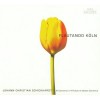Biography
Johann Christian Schickhardt (c. 1682 – c. 25 March 1762[1]) was a German composer and woodwind player.
Schickhardt was born in Braunschweig (Brunswick) and received his musical education at the Braunschweig-Wolfenbüttel court under the patronage of Augustus William, third son and heir of Anthony Ulrich, Duke of Brunswick-Wolfenbüttel.[2] In the first decade of the 18th century, he was employed in the Netherlands and associated with Friedrich of Hesse-Cassel, Henriëtte Amalia van Anhalt-Dessau (daughter of John George II, Prince of Anhalt-Dessau and widow of Henry Casimir II, Prince of Nassau-Dietz) and her son John William Friso, Prince of Orange.[3] In the second decade of the 18th century, Schickhardt lived in Hamburg, where it is speculated by musicologist Andrew D. McCredie that he was a member of the Hamburg Opera in Gänsemarkt as a flutist or oboist.[4] There is evidence suggesting that, in the 1720s, Schickhardt could have been an occasional oboist with the court orchestra of Leopold, Prince of Anhalt-Köthen, employer of Johann Sebastian Bach.[5] By the 1740s, records place Schickhardt at the University of Leiden as a student, and at his death in 1762, the university described him as "a master of musical arts and a member of the Academy," although there is no surviving record of his musical activity in Leiden otherwise.
In the first half of the 18th century, numerous works of his, mostly chamber music featuring the treble recorder, appeared in print from publishers Estienne Roger and Le Cène in Amsterdam. At least 30 sets of musical works are known to have been published, some of which are no longer extant. A catalog of Schickhardt's published and manuscript works can be found in David Lasocki's article. With the revival of the treble recorder in the early 20th century, a great interest in suitable repertoire for the instrument developed and some of Schickhardt's works were republished in new editions. It is predominantly through his works for recorder that Schickhardt is known today.
Schickhardt's compositions include sonatas for solo recorder and basso continuo (op. 1 and op. 17) as well as trio sonatas for two recorders and basso continuo (op. 16). Besides these, there are also compositions that stand between the chamber and larger scale concert music styles, e.g., his op. 9 for four recorders and basso continuo and his six sonatas for recorder, two oboes, and basso continuo. Some short works by Schickhardt can also be found in the The Compleat Tutor to the Hautboy, an oboe tutor published by Walsh and Hare about 1715.[7] Additionally, Schickhardt wrote a recorder concerto in G minor and L'Alphabet de la musique (op. 30, c. 1735), which contains sonatas in all 24 keys.







![Nederlandse Komponisten uit de gouden eeuw van de Barok [CD2of2]](http://static.classicalm.com/repository/disk-cover/small/3609-img1404831719124831.jpg)
